Eating insects to save the planet?
Eating insects to save the planet?
This article is from:https://www.newsmarket.com.tw/blog/94818/
Italy Correspondent, Zheng Jieyi
A crisis is also an opportunity, often containing potential for new business ventures.
Greenhouse effects and climate change pose a significant threat to agriculture, which relies heavily on favorable weather conditions. The United Nations Food and Agriculture Organization (FAO), in its 2006 report *Livestock's Long Shadow*, highlighted that 18% of global greenhouse gas emissions, measured in carbon dioxide equivalents, come from the livestock sector. Additionally, livestock manure is a major source of nitrous oxide emissions. The once desirable meat and dairy products have now become detrimental to the health of our planet.
The intensive farming model has become a major target of criticism, prompting humanity to search for alternative protein sources. Beyond traditional legumes, insects like crickets and mealworms have emerged as eco-friendly and nutritious new contenders in the food scene. Black soldier flies, in particular, offer dual benefits: they can both help manage waste and serve as a sustainable protein source for feed, embodying the potential of a "circular economy."
Low emissions, low energy consumption, and rich in protein—these are the benefits insects offer. They can even turn waste into valuable resources, transforming manure into "gold."
The crisis in the livestock industry has become an opportunity for the insect farming sector, with businesses sensing the potential for profit.
In 2013, Belgium became the first EU country to introduce spreads containing mealworms, such as carrot, tomato, and chocolate spreads. Meanwhile, neighboring Netherlands incorporated crickets into dishes and even served insect-based meals at diplomatic banquets.
Aside from bees, insects have played only a minor role in Europe's cuisine. To break the stigma surrounding insect consumption, promoters have aligned with the sustainability movement, waving the banner of environmentalism. The UN's Food and Agriculture Organization (FAO) provided strong endorsement with its 2013 report, *Edible Insects*, supporting the cause.
The report *Edible Insects* indicates that cold-blooded animals require less energy, making insects highly efficient in converting feed into meat. To produce one kilogram of edible live crickets, only 1.7 kilograms of feed is needed. In comparison, producing one kilogram of chicken requires 2.5 kilograms of feed, pork requires 5 kilograms, and beef requires 10 kilograms of feed.
The greenhouse gas emissions from mealworms, crickets, and grasshoppers are approximately only one percent of that from traditional livestock. Additionally, mealworms are drought-resistant, and their farming process requires significantly less water. Some insects, like black soldier flies, can thrive on animal and human waste as well as kitchen scraps. After consuming waste, they can then be used as livestock feed, exemplifying a seamless "circular economy."
Insects, which have low emissions, low energy requirements, and are rich in protein while being able to turn "waste into gold," are truly a dietary savior. However, in the past, Europeans have not recognized their value. To encourage Europeans to eat insects, it's essential to overcome not just the perception of "disgust," but also to establish a regulatory framework that manages public health, food safety, and environmental risks.
In Belgium, breeding edible insects must comply with GHP, GMP, and HACCP standards.
In the absence of clear EU regulations, Belgium and the Netherlands have allowed insects on the table through domestic laws.
Sauces containing mealworms entered the market by adopting a "fait accompli" strategy. Initially, they were banned by the Belgian Federal Food Safety Agency for violating food safety regulations but were legalized after new laws were passed.
In 2014, the Belgian Federal Food Safety Agency approved ten types of insects as food, including crickets, grasshoppers, silkworms, wax moth larvae, mealworms, Alphitobius diaperinus (lesser mealworm), and Alphitobius laevigatus (black cleaner beetle). However, the importation of similar insects was prohibited, and insect protein extracts were not allowed for human consumption.
Additionally, breeders and manufacturers of edible insects must meet standards such as Good Hygiene Practices (GHP), Good Manufacturing Practices (GMP), and Hazard Analysis and Critical Control Points (HACCP).
In the Netherlands, beyond human consumption, the insect market is also expanding into pet food, livestock feed, and agricultural fertilizer. Some companies have introduced insect-derived proteins, fats, and chitin.
Insects are considered "novel foods" in the EU and must undergo risk assessments before entering the market. In response to the rapidly growing insect population amid legislative loopholes, the EU finally amended the law in November 2015.
Even though eating insects is not a new concept in Africa, Asia, and Latin America, insect-based food was rarely seen in Europe before the EU's Food and Food Ingredients Regulation came into effect in 1997. As a result, insects are classified as "novel foods" in the EU and must undergo risk assessments before they can be legally marketed in the European Union.
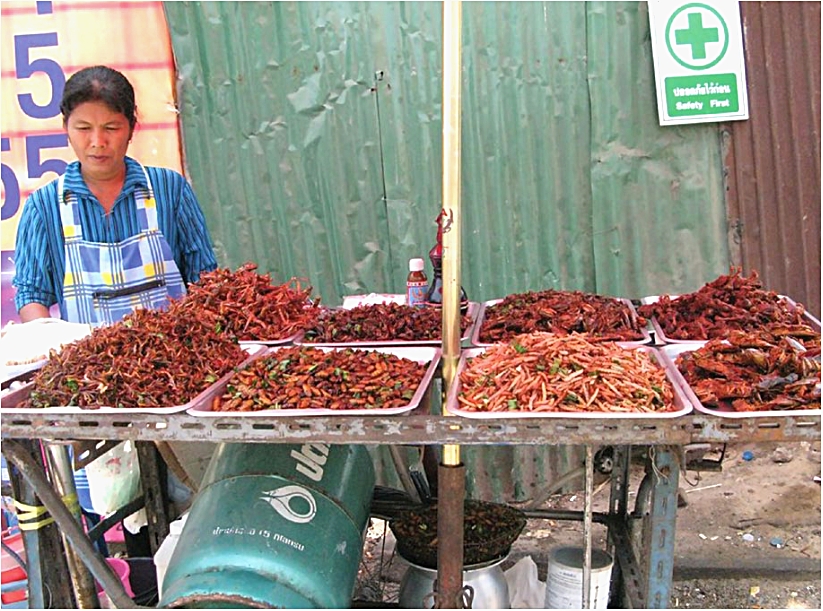
Insect snack stalls on the streets of Thailand (Source: FAO)
The European Food Safety Authority (EFSA) also published a risk assessment report in October 2015, highlighting the potential biological, chemical, allergenic, and environmental risks of using insects as food and feed. This serves as a scientific reference for further legislation and enforcement.
Regarding biological risks, the European Food Safety Authority (EFSA) pointed out that these are related to the substrate insects consume and the conditions in which they are reared. While insects have a limited likelihood of carrying pathogens commonly found in vertebrates, such as Salmonella and E. coli, they may contract parasites in farm environments. Processing methods like freezing and cooking can help reduce these risks.
Insects may be contaminated by dioxins and heavy metals, and pesticide residues should also be monitored.
The European Food Safety Authority (EFSA) stated that the stage at which insects are harvested affects the level of chemical residues, and further research is needed on the extent of chemical contamination in insects.
The Belgian Federal Food Safety Agency has also warned of the need to monitor dioxins, polychlorinated biphenyls (PCBs), heavy metals, pesticides, and fungicides. Antibiotics commonly used in traditional livestock farming may also be employed by insect farmers seeking to boost production, and the risks of drug use must be assessed.
Although the source of contamination in Taiwan's "dioxin eggs" scandal remains unknown, the lax management of feed is an undeniable issue. Given the history of dioxin contamination in European feed, when insects enter the human food chain, their feed must be regulated similarly.
There have been reports of allergic reactions to edible insects in Asia, though scientific research on the subject is limited. Individuals with allergies to shellfish or mites may also be at risk of allergic reactions to insects, so packaging must include appropriate labeling.
Regarding environmental risks, EFSA asserts that waste generated from insect farming must be managed similarly to waste from current livestock farming practices, meaning insect farmers must obtain permits for pollutant emissions.
Insects also have welfare concerns, and the impact of large-scale farming needs to be assessed.
The Italian NGO "Società Umanitaria" published the *White Paper on Edible Insects*, calling for more precise evaluations, as the risks associated with industrial-scale farming cannot be compared to small-scale, family-run operations.
Due to the limited scientific research on edible insects, experiences from beekeeping in agriculture, silkworm farming in the textile industry, and cochineal farming in the dye industry can serve as references for observing the behavior of insects in high-density farming. Different insect species have varying physiological responses, so research methods for studying greenhouse gas emissions must be tailored to the specific insect species.
The *White Paper on Edible Insects* emphasizes that "insect factories" should be closed systems to reduce the risk of farmed insects escaping and interbreeding with native species, which could harm the ecosystem. When assessing the impact on biodiversity, it is important not to focus solely on the population of specific species, but rather to consider the overall structure and function of the ecosystem.
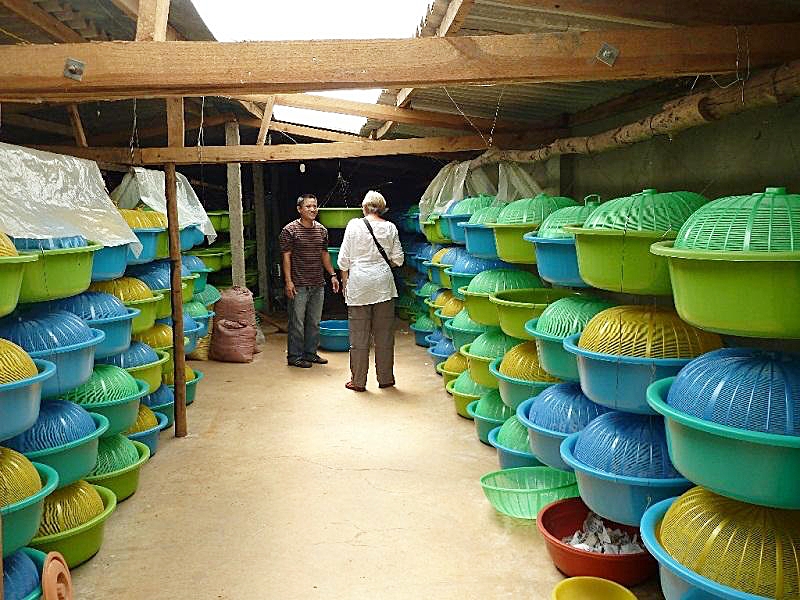
European consumers are increasingly aware of animal welfare, with some vegans even opposing the "exploitation" of bees, rejecting honey and pollen. Now that insects are becoming a new source of protein, large-scale insect farming also faces ethical challenges. The *White Paper on Edible Insects* warns that, just like any intensive farming, insects may face new health threats.
According to industry experience, the Dutch Food Safety Authority has noted that to reduce intestinal waste, insects are often starved for several days before harvesting in a process known as "gut emptying."
As for the impact of feeding insects, Italy’s *White Paper on Edible Insects* points out that research has shown chitin in insects may enhance the immune system of fish. However, the polysaccharides in chitin could potentially affect intestinal absorption, ultimately slowing down fish growth rates.
Animal Feed as the Primary Market for Insect Farming
"From a global perspective, the population continues to grow, and people's meat consumption is increasing, especially in countries like China. Therefore, we need sustainable sources of protein," said British biologist Elaine Fitches, who is involved in the "Protein Insects" (PROteINECT) research project.
Insect-eating advocates echo Malthusian notions of population growth and draw parallels with the agricultural "Green Revolution" following World War II, as well as the advent of genetically modified crops in the 1990s. However, the reality is that large quantities of genetically modified corn and soybeans end up in the stomachs of pigs and cows, rather than feeding the hungry.
The "Protein Insects" research report states clearly that "the EU faces a 'protein deficit,' with over 70% of animal feed protein relying on imports. Since 1940, global meat consumption has quadrupled, and the rapidly growing aquaculture sector also requires protein-rich feed."
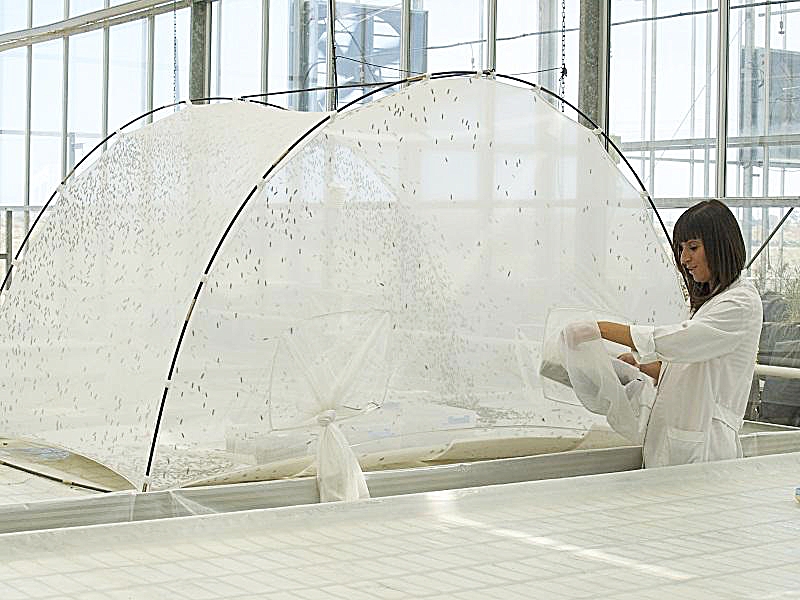
To avoid ecological disruption, "insect factories" should be enclosed facilities (source: FAO).
The "Food and Environment Research Agency" (Fera) is one of the main backers of the "Protein Insect" project. In addition to the UK's Department for Environment, Food & Rural Affairs (DEFRA) holding a 25% stake, 75% of Fera's funding comes from Capita. Established in 1984, Capita is the UK's largest business outsourcing company, managing a wide range of healthcare and education contracts amid government reforms of the welfare system, with a turnover of £4.7 billion in 2015.
In China, where there is a tradition of eating insects, the insect farming industry has grown rapidly in recent years. Guangdong Institute of Entomology and Huazhong Agricultural University have also joined the Protein Insect (PROteINECT) research project.
Insect farming enterprises see great potential, and while regulations may seem restrictive, they are also crucial for shaping future standards in the agri-food industry and international trade. In addition to lobbying for regulatory changes, EU businesses are striving to establish a management framework.
Learning from the lessons of mad cow disease, assessing prion protein risks in insects
Factory farming has long used "scientific" methods to feed livestock with single nutrients, such as grinding up or extracting proteins from leftover animal parts like bones to feed cattle. This cost-saving and waste-reducing strategy seemed effective until prion proteins were found to cause mad cow disease, leading governments to ban the practice.
To avoid a repeat of this disaster, the European Food Safety Authority (EFSA) warns that if insects are fed with substrates derived from humans or ruminants, the risks of prion proteins must be carefully assessed.
Under pressure from industry lobbying, the European Commission agreed in late 2016 to allow the use of insect protein in fish feed starting in July of this year.
Industry players hope that insect protein can soon be used in chicken and pig feed as well. However, "This will require the development of tests to distinguish between pig or chicken proteins and insect proteins, to prevent the risk of cross-species protein contamination," said Antoine Hubert, chairman of the International Platform of Insects for Food and Feed (IPIFF).
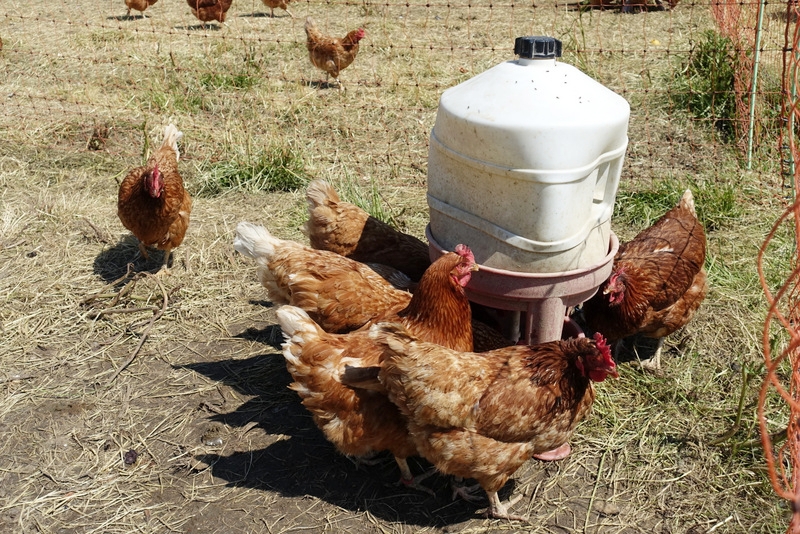
辨識蛋白質的檢測法建立後,業者將推昆蟲蛋白質養雞(攝影/鄭傑憶)
Insects Managed Like Livestock, Prohibition on Using Waste as Feed
Currently, the European Union categorizes insect farming under livestock management, applying the same regulations to the feed used. Therefore, the use of manure, kitchen waste, and leftover food containing meat or fish ingredients for feeding insects is prohibited. Additionally, if insect protein is to be used for feeding livestock intended for human consumption, it must undergo hydrolysis; insects that have not gone through this process can only be used for pet food.
Antoine Hubert advocates for a careful evaluation by the EU on the use of kitchen waste containing meat and fish for feeding insects, arguing that "this represents a real business opportunity," but he also admits that there is currently insufficient research to prove its safety.
The FAO's report on edible insects outlines the process of converting organic waste into feed after insects consume it, presenting it as a sustainable and cost-effective solution.
American researcher Craig Sheppard and others proposed as early as 1994 that black soldier flies could "add value" to pig manure: by consuming half of the pig waste, the dried black soldier flies provide nutrients that are particularly suitable as fish feed. Sheppard submitted a related report to North Carolina State University's Animal Waste Management Center in 2005.
“Pink Lagoon" That Even Black Soldier Flies Can't Digest
Located in the central eastern part of the state, North Carolina has transformed into a major pig-farming state following the decline of the tobacco industry, with factory farms housing millions of pigs at any given time. In 2013, China's WH Group acquired Smithfield Foods, the largest pork producer in the U.S., for $4.7 billion, and the company originated in North Carolina, where it still operates the largest slaughterhouse and processing plant in the country.
The presence of thousands of pigs also means an accumulation of waste, more accurately described as "piling up like a lake." The large wastewater lagoons where pig waste is stored are jokingly referred to as "pink lagoons" due to the color caused by the mixture of blood and bacterial activity. Beneath this romantic name lies a deadly crisis, filled with bacteria, antibiotic residues, heavy metals, and nitrogen compounds.
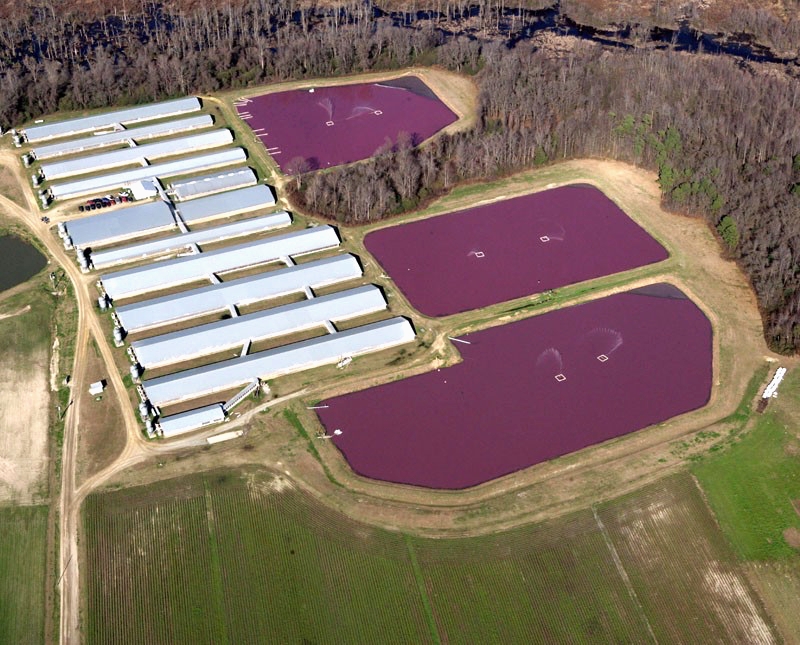
**"Pink Lagoon" That Even Black Soldier Flies Can't Digest (Source: songster.net)**
More than 20 years after Craig Sheppard's research, the "circular economy" of black soldier flies processing pig manure has evidently not materialized. A flood in 2016 washed away at least 14 "pink lagoons," triggering an environmental crisis that also threatened the health of nearby residents.
The industrialized and intensive farming methods have led to a "quantitative change leading to qualitative change." While animal manure in small-scale family farms is a valuable fertilizer, the waste from large pig farms becomes toxic. Although there is optimism about the potential of insects, the EU, Belgium, and Italy all prohibit livestock and insects fed on waste from entering the human food chain.
Under the guise of environmental protection and the moral temptation to alleviate hunger, if there isn't a calm and objective assessment of various stakeholders' interests, along with the establishment of legal and enforcement frameworks, the opportunities and possibilities in insect farming may also harbor significant risks.